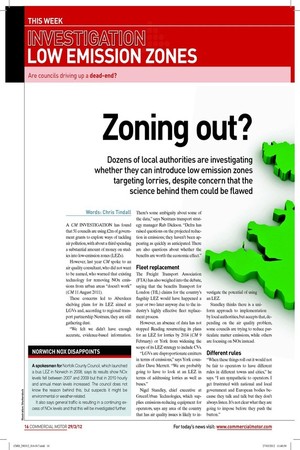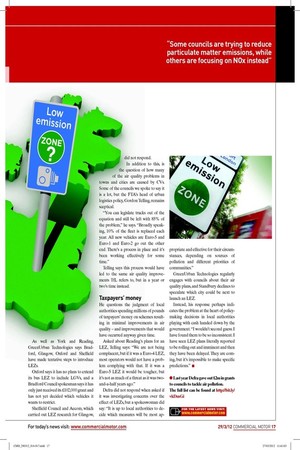Zoning out?
Page 12

Page 13

If you've noticed an error in this article please click here to report it so we can fix it.
LOW EMISSION ZONES
Are councils driving up a dead-end?
Dozens of local authorities are investigating whether they can introduce low emission zones targeting lorries, despite concern that the science behind them could be flawed
Words: Chris Tindall
A CM INVESTIGATION has found that 51 councils are using £2m of government grants to explore ways of tackling air pollution, with about a third spending a substantial amount of money on studies into low-emission zones (LEZs).
However, last year CM spoke to an air quality consultant, who did not want to be named, who warned that existing technology for removing NOx emissions from urban areas “doesn’t work” (CM 11 August 2011).
These concerns led to Aberdeen shelving plans for its LEZ aimed at LGVs and, according to regional transport partnership Nestrans, they are still gathering dust.
“We felt we didn’t have enough accurate, evidence-based information. There’s some ambiguity about some of the data,” says Nestrans transport strategy manager Rab Dickson. “Defra has raised questions on the projected reduction in emissions; they haven’t been appearing as quickly as anticipated. There are also questions about whether the beneits are worth the economic effect.”
Fleet replacement
The Freight Transport Association (FTA) has also weighed into the debate, saying that the beneits Transport for London (TfL) claims for the country’s lagship LEZ would have happened a year or two later anyway due to the industry’s highly effective leet replacement process.
However, an absence of data has not stopped Reading resurrecting its plans for an LEZ for lorries by 2014 (CM 9 February) or York from widening the scope of its LEZ strategy to include CVs.
“LGVs are disproportionate emitters in terms of emissions,” says York councillor Dave Merrett. “We are probably going to have to look at an LEZ in terms of addressing lorries as well as buses.” Nigel Standley, chief executive at GreenUrban Technologies, which supplies emissions-reducing equipment for operators, says any area of the country that has air quality issues is likely to in vestigate the potential of using an LEZ.
Standley thinks there is a uniform approach to implementation by local authorities, but accepts that, depending on the air quality problem, some councils are trying to reduce particulate matter emissions, while others are focusing on NOx instead.
Different rules
“When these things roll out it would not be fair to operators to have different rules in different towns and cities,” he says. “I am sympathetic to operators. I get frustrated with national and local government and European bodies because they talk and talk but they don’t always listen. It’s not clear what they are going to impose before they push the button.” As well as York and Reading, GreenUrban Technologies says Bradford, Glasgow, Oxford and Shefield have made tentative steps to introduce LEZs.
Oxford says it has no plans to extend its bus LEZ to include LGVs, and a Bradford Council spokesman says it has only just received its £102,000 grant and has not yet decided which vehicles it wants to restrict.
Shefield Council and Aecom, which carried out LEZ research for Glasgow, did not respond.
In addition to this, is the question of how many of the air quality problems in towns and cities are caused by CVs. Some of the councils we spoke to say it is a lot, but the FTA’s head of urban logistics policy, Gordon Telling, remains sceptical.
“You can legislate trucks out of the equation and still be left with 85% of the problem,” he says. “Broadly speaking, 10% of the leet is replaced each year. All new vehicles are Euro-5 and Euro-1 and Euro-2 go out the other end. There’s a process in place and it’s been working effectively for some time.” Telling says this process would have led to the same air quality improvements TfL refers to, but in a year or two’s time instead.
Taxpayers’ money
He questions the judgment of local authorities spending millions of pounds of taxpayers’ money on schemes resulting in minimal improvements in air quality – and improvements that would have occurred anyway given time.
Asked about Reading’s plans for an LEZ, Telling says: “We are not being complacent, but if it was a Euro-4 LEZ, most operators would not have a problem complying with that. If it was a Euro-5 LEZ it would be tougher, but it’s not as much of a threat as it was twoand-a-half years ago.” Defra did not respond when asked if it was investigating concerns over the effect of LEZs, but a spokeswoman did say: “It is up to local authorities to decide which measures will be most ap propriate and effective for their circumstances, depending on sources of pollution and different priorities of communities.” GreenUrban Technologies regularly engages with councils about their air quality plans, and Standbury declines to speculate which city could be next to launch an LEZ.
Instead, his response perhaps indicates the problem at the heart of policymaking decisions in local authorities playing with cash handed down by the government. “I wouldn’t second guess. I have found them to be so inconsistent. I have seen LEZ plans literally reported to be rolling out and imminent and then they have been delayed. They are coming, but it’s impossible to make speciic predictions.” n
● Last year Defra gave out £fim in grants to councils to tackle air pollution. The full list can be found at http://bit.ly/ vkDmGi
NORWICH NOX DISAPPOINTS
A spokesman for Norfolk County Council, which launched a bus LEZ in Norwich in 2008, says its results show NOx levels fell between 2007 and 2009 but that in 2010 hourly and annual mean levels increased. The council does not know the reason behind this, but suspects it might be environmental or weather-related.
It also says general traffic is resulting in a continuing excess of NOx levels and that this will be investigated further.












































